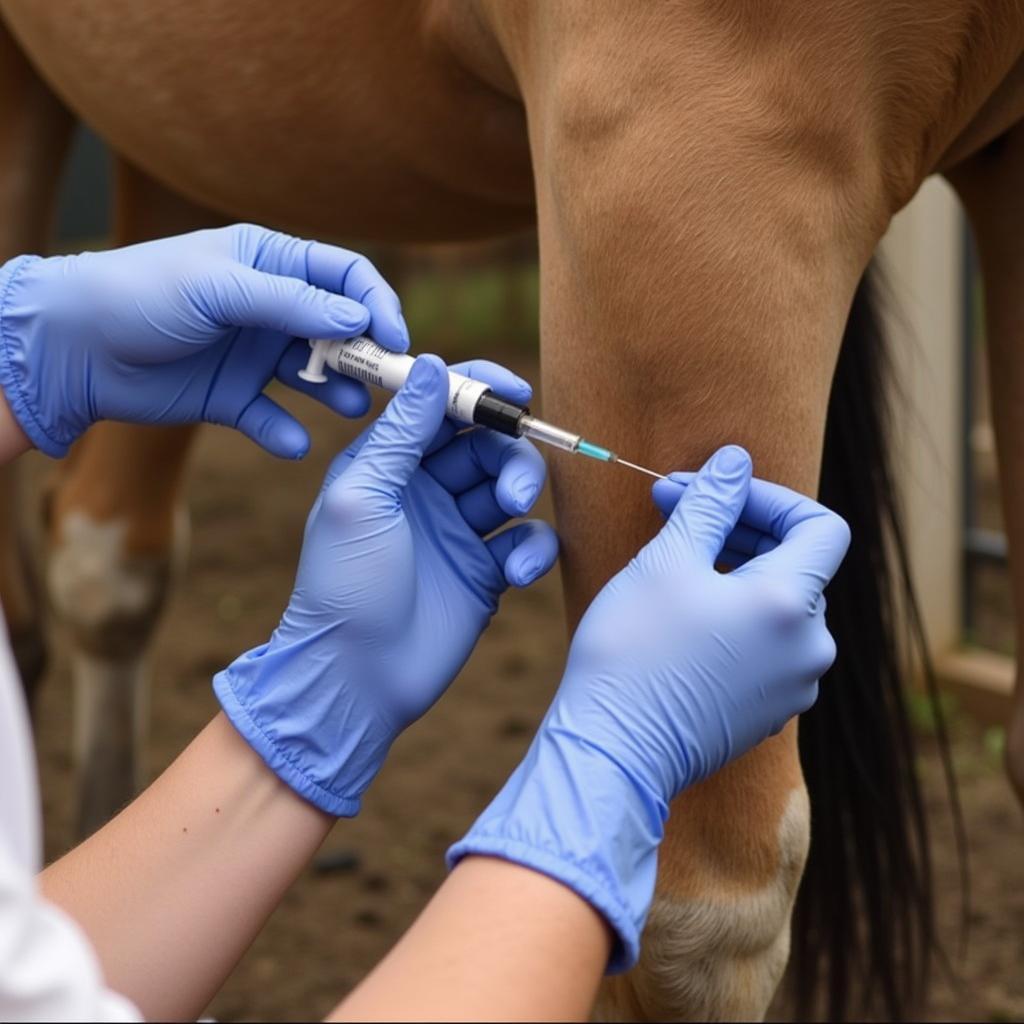Arthramid For Horses Cost is a significant consideration for horse owners exploring this innovative treatment for joint lameness. This guide delves into the factors influencing Arthramid’s price, its benefits, potential risks, and alternative treatment options.
Understanding Arthramid for Horses
Arthramid is a polyacrylamide hydrogel that is injected into a horse’s affected joint. It acts as a scaffold, stimulating the body’s natural healing processes and promoting the production of new, healthy synovial fluid, which lubricates the joint and reduces pain and inflammation. This treatment is particularly effective for osteoarthritis and other degenerative joint diseases.
Factors Affecting Arthramid for Horses Cost
Several factors contribute to the overall cost of Arthramid treatment:
- Veterinarian Fees: The experience and location of your veterinarian will influence their fees. Specialists typically charge more than general practitioners.
- Diagnostic Procedures: Before administering Arthramid, your veterinarian might recommend diagnostic imaging like X-rays or ultrasounds to assess the joint’s condition, adding to the overall cost.
- Number of Injections: The required number of Arthramid injections varies depending on the severity of the joint issue and the horse’s individual response to the treatment. Some horses may only need one injection, while others may require multiple injections for optimal results.
- Follow-up Care: Post-treatment care, including rest and controlled exercise, also contributes to the overall cost.
 Arthramid Injection Procedure for Horses
Arthramid Injection Procedure for Horses
Benefits of Arthramid for Horses
Despite the arthramid for horses cost, many horse owners find it a worthwhile investment due to its potential benefits:
- Reduced Pain and Inflammation: Arthramid can significantly alleviate pain and inflammation in affected joints, improving the horse’s comfort and mobility.
- Improved Joint Function: By stimulating the production of healthy synovial fluid, Arthramid helps restore joint function and range of motion.
- Long-lasting Effects: The benefits of Arthramid can last for several months or even years, making it a cost-effective option in the long run.
- Minimally Invasive: Arthramid injections are minimally invasive compared to surgical interventions, reducing recovery time and associated risks.
Potential Risks and Side Effects
While Arthramid is generally considered safe, there are potential risks and side effects to be aware of:
- Joint Flare-up: Some horses may experience a temporary increase in pain and inflammation immediately after the injection.
- Infection: Although rare, there is a risk of infection at the injection site.
- Allergic Reactions: Horses can have allergic reactions to Arthramid, though this is uncommon.
 Horse Leg Anatomy Showing Joint Affected by Arthritis
Horse Leg Anatomy Showing Joint Affected by Arthritis
Arthramid vs. Other Joint Treatments
Several other treatments are available for joint issues in horses. Here’s a brief comparison:
- Corticosteroids: These offer quick pain relief but don’t address the underlying cause of the problem. They are often less expensive per treatment than Arthramid but may require more frequent administration.
- Hyaluronic Acid (HA): HA injections improve joint lubrication but their effects are generally shorter-lived than Arthramid.
- IRAP (Interleukin-1 Receptor Antagonist Protein): IRAP therapy is a more advanced treatment that targets inflammation, but it can be more expensive than Arthramid.
- Stem Cell Therapy: This is a cutting-edge treatment with potential for long-term benefits, but it is considerably more expensive than Arthramid.
Arthramid for Horses Cost: Is it Worth It?
While arthramid for horses cost can vary, its potential for long-term pain relief and improved joint function makes it a viable option for many horse owners. The cost-effectiveness of Arthramid becomes more apparent when considering the potential reduction in the need for other medications and treatments.
Conclusion
Arthramid for horses cost should be evaluated in conjunction with its potential benefits, the severity of the horse’s condition, and alternative treatment options. Consult with your veterinarian to determine if Arthramid is the right choice for your horse. They can provide a personalized assessment and discuss the expected costs based on your horse’s specific needs. Ultimately, the investment in Arthramid can significantly improve your horse’s quality of life, allowing them to return to comfortable movement and activity.
FAQ
- How long does an Arthramid injection take? The injection itself is relatively quick, usually taking just a few minutes.
- How long does it take to see results after Arthramid? Most horse owners observe improvements within a few days to a couple of weeks.
- How long do the effects of Arthramid last? The effects typically last for several months to a year or more.
- Are there any restrictions on activity after Arthramid treatment? Your veterinarian will recommend a specific rehabilitation plan involving controlled exercise and rest.
- Is Arthramid suitable for all types of joint problems in horses? Arthramid is most effective for osteoarthritis and other degenerative joint conditions.
- What are the signs of joint pain in horses? Common signs include lameness, stiffness, swelling, and reluctance to move.
- Can Arthramid be used in combination with other joint treatments? Yes, in some cases, Arthramid can be used in conjunction with other therapies.
Need more information? Explore our other articles on equine health and wellness on Justus Horses USA.
For personalized advice and support regarding Arthramid for your horse, contact us at Phone: 0772127271, Email: [email protected], or visit us at QGM2+WX2, Vị Trung, Vị Thuỷ, Hậu Giang, Việt Nam. Our customer care team is available 24/7.